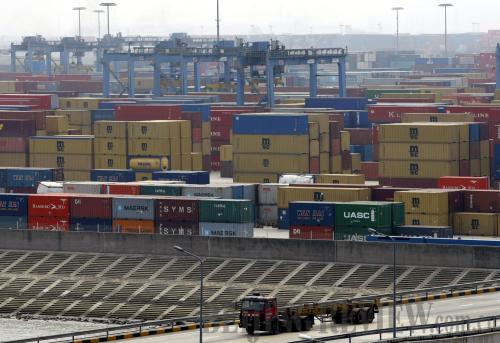|
 |
|
EXPORT RECOVERY: Containers at Shanghai's Waigaoqiao cargo port await shipment overseas. China's exports made a slight recovery in the first half of 2010 (CFP) |
Without a doubt, the Chinese economy has sailed safely through the global economic downturn, while the developed world struggles to restart its growth engine. China's economic momentum remained strong in the first half of this year, though the growth rate is heading south in the second quarter. So what risks lie ahead? How is the country's economic rebalancing progressing? Beijing Review interviewed three experts to get their insights on these issues. Edited excerpts follow:

Zheng Xinli, Vice Chairman of China Center for International Economic Exchanges:
Long Way to Go
Despite a mild slowdown in the second quarter, the Chinese economy remains on a steady course of growth. While the world economy faces the risk of a "double dip," China appears to be a bright spot in a dim international landscape.
Major indexes, such as investments and industrial output, have indicated a slowdown, dismissing worries over the overheating economy and inflation. For the year as a whole, the economy is likely to grow by around 10 percent, well above the government-set target of 8 percent.
But the Chinese economy was not without worries. The local government debt continues to stretch the patience of policy makers, and exporters are yet to fully recover their strength. To make up for plunging exports, the government kicked off an investing spree and directed massive bank credit into the economy. This may have complicated the efforts to rebalance the economy. That is why the authorities need to maintain flexible policies to spur growth and also adjust the economic structures.
My suggestions are as follow.
First, continue to expand domestic demands and stimulate the consumer market. Efforts are needed to increase the income of residents. There are some viable options, including raising the minimum wage standard and encouraging listed state-owned enterprises to pay dividends to their investors. It would also be helpful to bump up the minimum purchase price of grain and boost the income of farmers.
Second, encourage private sector investments and allow private investors into restricted fields like finance. This would strengthen the vitality of the financial industry and help soothe fund shortages of small and medium-sized enterprises.
Third, support the service sector, which is environmentally friendly and instrumental in job creation. The government is supposed to hand out incentives for starting up one's own businesses.
Fourth, help labor-intensive enterprises move up the value chain and press ahead with indigenous innovation. Measures can be taken to support their research and development and strengthen the protection of intellectual property rights in the country.
Fifth, bolster international influence of the renminbi and encourage Chinese companies to establish international footholds and acquire valuable resources and assets overseas. Policy makers are also supposed to diversify investments of foreign exchange reserves and fend off financial risks.
| 